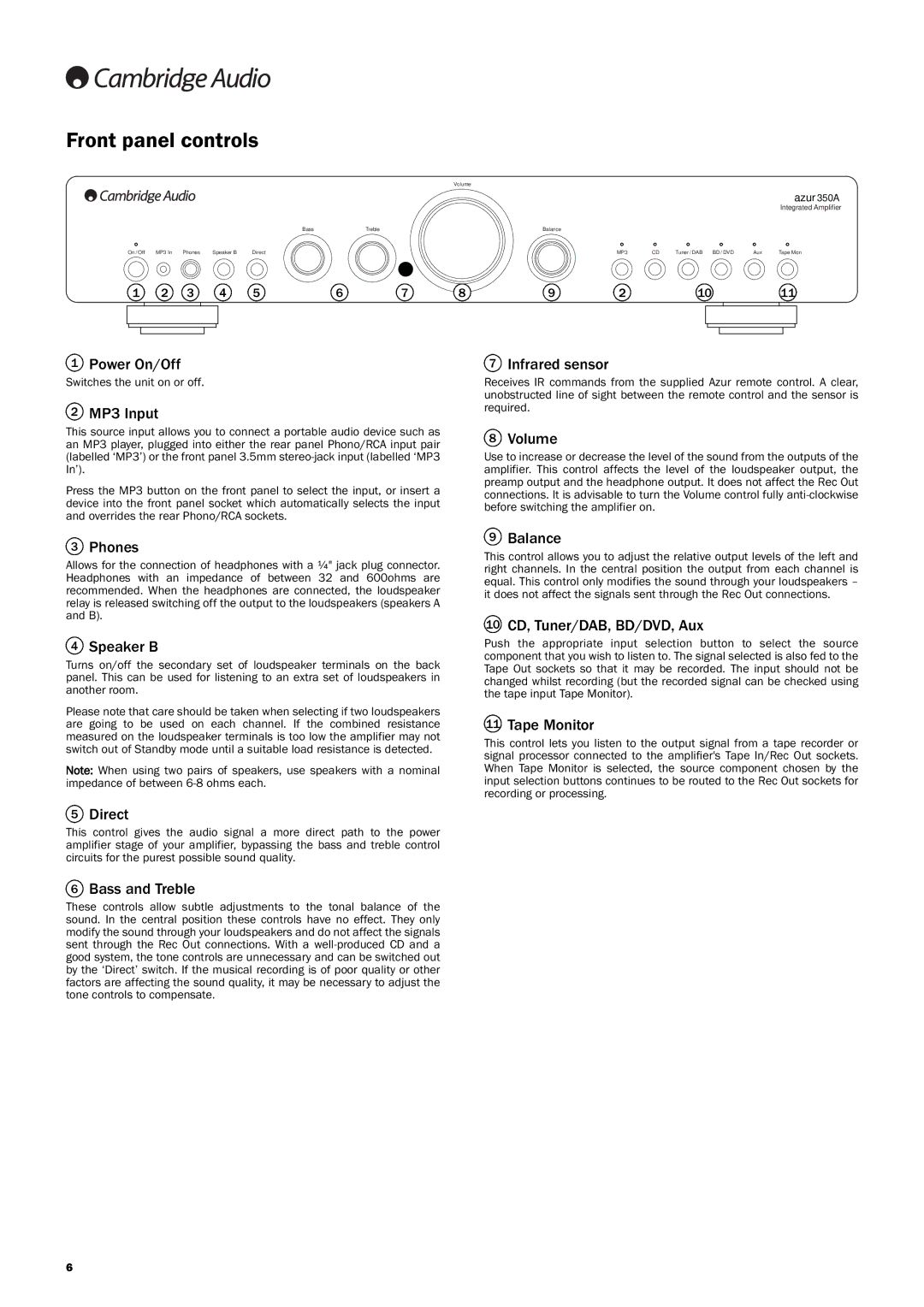
Front panel controls
Volume
azur 350A
Integrated Amplifier
|
|
|
| Bass | Treble | Balance |
|
|
|
|
|
On / Off | MP3 In | Phones | Speaker B | Direct |
| MP3 | CD | Tuner / DAB | BD / DVD | Aux | Tape Mon |
1 | 2 | 3 | 4 | 5 | 6 | 7 | 8 | 9 | 2 | 10 | 11 |
1Power On/Off
Switches the unit on or off.
2MP3 Input
This source input allows you to connect a portable audio device such as an MP3 player, plugged into either the rear panel Phono/RCA input pair (labelled ‘MP3’) or the front panel 3.5mm
Press the MP3 button on the front panel to select the input, or insert a device into the front panel socket which automatically selects the input and overrides the rear Phono/RCA sockets.
7Infrared sensor
Receives IR commands from the supplied Azur remote control. A clear, unobstructed line of sight between the remote control and the sensor is required.
8Volume
Use to increase or decrease the level of the sound from the outputs of the amplifier. This control affects the level of the loudspeaker output, the preamp output and the headphone output. It does not affect the Rec Out connections. It is advisable to turn the Volume control fully
3Phones
Allows for the connection of headphones with a ¼" jack plug connector. Headphones with an impedance of between 32 and 600ohms are recommended. When the headphones are connected, the loudspeaker relay is released switching off the output to the loudspeakers (speakers A and B).
4Speaker B
Turns on/off the secondary set of loudspeaker terminals on the back panel. This can be used for listening to an extra set of loudspeakers in another room.
Please note that care should be taken when selecting if two loudspeakers are going to be used on each channel. If the combined resistance measured on the loudspeaker terminals is too low the amplifier may not switch out of Standby mode until a suitable load resistance is detected.
Note: When using two pairs of speakers, use speakers with a nominal impedance of between
5Direct
This control gives the audio signal a more direct path to the power amplifier stage of your amplifier, bypassing the bass and treble control circuits for the purest possible sound quality.
6Bass and Treble
These controls allow subtle adjustments to the tonal balance of the sound. In the central position these controls have no effect. They only modify the sound through your loudspeakers and do not affect the signals sent through the Rec Out connections. With a
9Balance
This control allows you to adjust the relative output levels of the left and right channels. In the central position the output from each channel is equal. This control only modifies the sound through your loudspeakers – it does not affect the signals sent through the Rec Out connections.
10CD, Tuner/DAB, BD/DVD, Aux
Push the appropriate input selection button to select the source component that you wish to listen to. The signal selected is also fed to the Tape Out sockets so that it may be recorded. The input should not be changed whilst recording (but the recorded signal can be checked using the tape input Tape Monitor).
11Tape Monitor
This control lets you listen to the output signal from a tape recorder or signal processor connected to the amplifier's Tape In/Rec Out sockets. When Tape Monitor is selected, the source component chosen by the input selection buttons continues to be routed to the Rec Out sockets for recording or processing.
6
